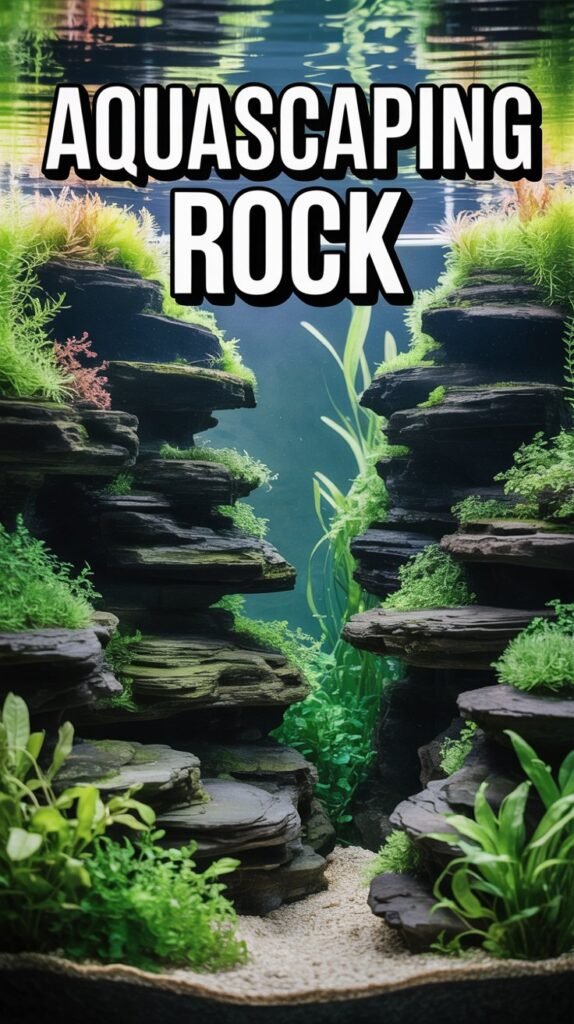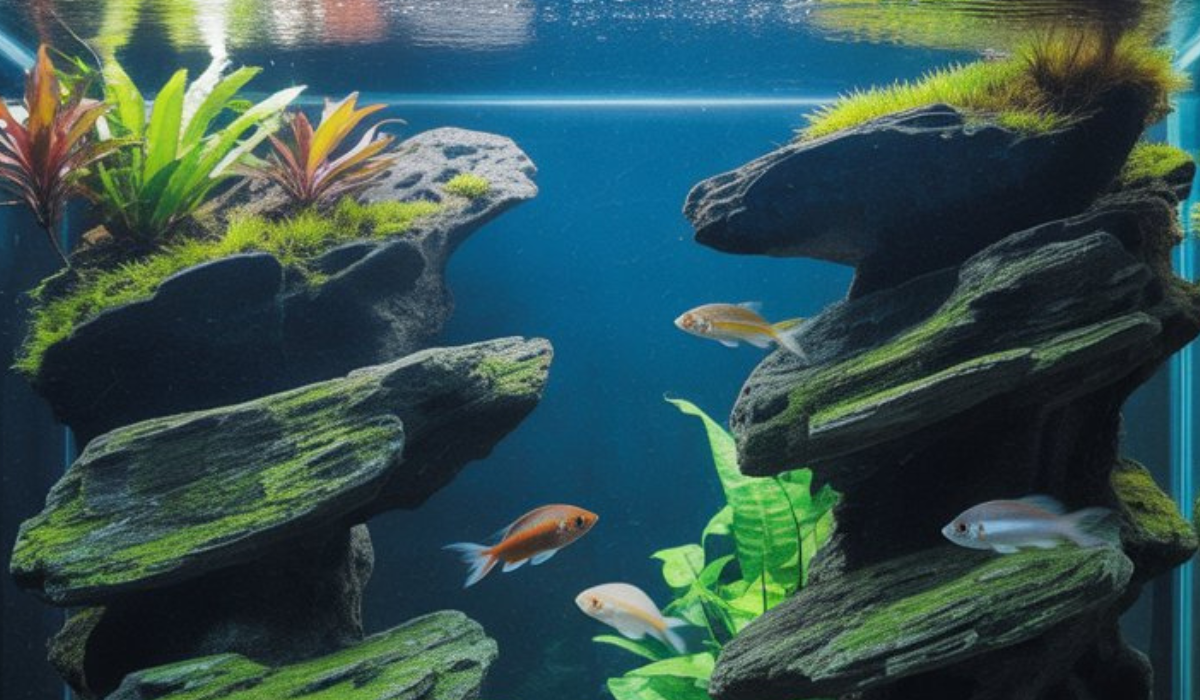Aquascaping is an art form that allows aquarists to transform a simple aquarium into a breathtaking underwater landscape. While plants, fish, and substrates play a significant role, aquascaping rocks are the true backbone of any design. They provide structure, height, contrast, depth, and stability to the layout. Whether you prefer a natural-looking Iwagumi layout, a dramatic mountain formation, or a jungle-style aquascape, choosing the right rocks is essential.
This comprehensive guide covers everything you need to know about aquascaping rocks—their types, selection, placement techniques, benefits, maintenance, safety considerations, and best practices. Whether you’re a beginner or an advanced aquascaper, this article will help you create a stunning aquascape that stands out.
What Are Aquascaping Rocks?
Aquascaping rocks are natural or man-made stones used to build hardscapes in planted or non-planted aquariums. They form the visual foundation of the layout, shaping the scape’s flow, depth, and structure. Rocks can mimic mountains, cliffs, valleys, caves, riverbeds, or even open grassy fields depending on how they are arranged.
They are commonly used in aquascaping styles such as:
- Iwagumi layout (minimalist stone-focused design)
- Nature aquarium style
- Diorama aquascaping
- Mountain-range layouts
- River and canyon aquascapes
- Jungle-style aquariums
Aquascaping rocks are chosen for their color, shape, texture, and impact on water chemistry. Some stones raise water hardness, while others remain inert. Understanding this helps maintain a stable environment for plants and fish.
Why Aquascaping Rocks Are Important

Using the right aquascaping rocks brings multiple benefits:
1. Structural Foundation
Rocks form the base of your aquascape. They allow you to create slopes, plateaus, elevation, and depth.
2. Visual Appeal
With their natural textures and shapes, rocks create a captivating, realistic underwater scene.
3. Plant Anchoring
Many plants, especially epiphytes like Anubias, Java Fern, and Bucephalandra, attach well to rocks.
4. Hiding Spots
Rocks provide caves and crevices for fish, shrimp, and fry, reducing stress and improving behavior.
5. Aquascaping Stability
Rock formations help hold substrate in place and prevent landslides caused by digging fish or strong water flow.
6. Natural Environment
They replicate natural habitats like stream beds, mountain zones, and riverbanks.
Types of Aquascaping Rocks

Choosing the right type of rock is the most important step. Below are the most commonly used aquascaping rocks and their characteristics.
1. Seiryu Stone
One of the most popular aquascaping rocks, Seiryu Stone is loved for its dramatic fissures and greyish-blue tones.
Features:
- Sharp edges
- White streaks and cracks
- Great for Iwagumi layouts
Note:
Seiryu Stone can raise pH and KH slightly, which is beneficial for some fish but may require water adjustments for soft-water species.
2. Dragon Stone (Ohko Rock)
Dragon Stone is known for its porous texture and brownish-green tones.
Features:
- Lightweight and easy to stack
- Safe for plants and fish
- Neutral effect on water chemistry
- Perfect for diorama and nature-style tanks
It’s also easier to break into smaller pieces for fine detailing.
3. Lava Rock
A highly porous volcanic rock often used in planted tanks and biological filtration.
Features:
- Extremely porous—excellent for beneficial bacteria
- Lightweight
- Affordable
- Does not change water parameters
Lava rock is ideal for anchoring plants and mosses.
4. Ryuoh Stone
Similar to Seiryu but with more rugged texture and darker coloration.
5. Manten Stone
A premium rock known for its beautiful texture and rich, natural shapes.
Features:
- Earthy brown tones
- Heavy and sturdy
- Great for complex layouts
Manten stones are often used in high-end aquascapes.
6. Petrified Wood
Not actually wood, but fossilized mineral stone.
Features:
- Wood-like appearance
- Ideal for jungle-themed aquascapes
- Neutral effect on water
Its layered texture gives an organic, ancient look.
7. Black Lava Stone
Popular in minimalist and modern scapes.
Features:
- Black to dark grey
- Porous
- Enhances plant contrast
Great for tanks with vibrant green plants.
8. Pagoda Stone
Known for its layered, carved appearance.
Features:
- Natural-looking geological layers
- Light brown to sandy tones
- Excellent for mountain-style aquascaping
9. Quartzite and Sandstone
Used for desert themes and river-style aquascapes.
Features:
- Soft colors
- Smooth surfaces
- Neutral for water chemistry
How to Choose the Right Aquascaping Rock

Here are important factors to consider when selecting rocks:
1. Water Chemistry Compatibility
Some rocks raise pH and hardness. For soft-water aquariums (like tetras, rasboras, or shrimp tanks), choose inert stones like:
- Dragon Stone
- Lava Rock
- Petrified Wood
For hard-water species (livebearers, cichlids), rocks like Seiryu or Ryuoh Stone work perfectly.
2. Color Harmony
Match rock colors with your plants, substrate, and background.
- Grey rocks = modern, clean look
- Brown rocks = warm, natural tone
- Black rocks = dramatic contrast
3. Texture and Pattern
Strong textures look better in larger tanks, while smooth stones suit minimalist layouts.
4. Rock Shape
Choose rocks that fit the scape type:
- Tall vertical stones → mountains
- Flat stones → terraces
- Round stones → riverbeds
5. Safety for Fish and Plants
Avoid rocks with sharp edges if you keep delicate fish like Bettas or Goldfish.
Preparing Aquascaping Rocks for Use
Before adding stones to your aquarium:
1. Rinse Thoroughly
Wash to remove dust, clay, or debris.
2. Scrub with a Brush
Removes organic matter and dirt.
3. Boil if Necessary
Especially for rocks collected outdoors—but avoid boiling fragile rocks like Dragon Stone, as they may crack.
4. Test Water Hardness
Place the rock in a bucket of water for 24–48 hours and test pH and KH. If levels rise significantly, the rock may not suit soft-water tanks.
Aquascaping Techniques Using Rocks
Designing an appealing layout requires planning and creativity. Below are the most popular aquascaping techniques.
1. The Rule of Thirds
Position major stones off-center to create balanced, natural-looking compositions.
2. Golden Ratio (1:1.618)
This principle guides the placement of the “master stone” or “Oyaishi” for ideal visual focus.
3. Iwagumi Rock Arrangement
An Iwagumi layout usually uses:
- One main stone (Oyaishi)
- Two supporting stones (Fukuishi and Soeishi)
- Additional accent stones
The focus is simplicity and harmony.
4. Building Height and Depth
Place larger rocks toward the back and smaller rocks toward the front to create a sense of depth.
5. Creating Caves and Crevices
Stack rocks securely to form caves for fish and shrimp.
6. Sloping the Substrate
A higher back slope allows rocks to appear more dramatic and natural.
7. Using Superglue or Epoxy
Secure unstable rocks to prevent collapse.
Popular Aquascape Layout Styles Using Rocks
1. Mountain Range Layout
Tall, jagged stones create the illusion of mountains, cliffs, and peaks.
2. Canyon or Valley Layout
Two rock formations create a pathway or valley shape.
3. Island Style
A cluster of rocks placed in the center with plants surrounding them.
4. Riverbank Style
Smooth stones placed along one side or across the tank to mimic natural riverbeds.
5. Jungle Layout
Petrified wood, lava rock, and Dragon Stone work well for a lush, overgrown look.
Aquascaping Rocks and Plants
Some plants grow best when attached to rocks. These include:
Epiphyte Plants
- Anubias
- Java Fern
- Bucephalandra
- Bolbitis
- Mosses (Java Moss, Christmas Moss)
Ground Covers
- Monte Carlo
- Dwarf Hairgrass
- Glossostigma
Stem Plants
Planted around rocks to create contrast.
Rocks hold plants in place, create shadows, and allow plant roots to spread naturally.
Maintaining Aquascaping Rocks
Keeping your rocks looking new enhances the beauty of the aquarium.
1. Clean Algae Regularly
Use a toothbrush or algae scraper.
2. Manage Lighting
Too much light = algae on rocks
Reducing light can keep stones looking clean.
3. Add Algae-Eating Fish and Shrimp
- Otocinclus
- Amano Shrimp
- Nerite Snails
4. Avoid Moving Rocks Often
Once placed, rocks should remain stable to prevent substrate disturbance.
Common Mistakes When Using Aquascaping Rocks
Avoid these errors:
- Using too many different rock types
- Ignoring water chemistry changes
- Poor stability leading to rock collapses
- Overcrowding the layout
- Lack of a central focal point
- Choosing rocks that clash in color and texture
Tips for Beginners
- Start with easily stackable stones like Dragon Stone or Lava Rock.
- Follow the Iwagumi principle for simple, beautiful layouts.
- Use a towel or cushion when setting rocks to avoid cracking the tank glass.
- Always create a test layout outside the tank first.
- Take inspiration from nature—mountains, rivers, cliffs.
Conclusion
Using aquascaping rock effectively can transform a simple aquarium into a masterpiece. Rocks bring stability, structure, height, and visual interest to the tank, regardless of whether you are creating an Iwagumi-style aquascape or a lush jungle theme. By selecting the right rocks, understanding their influence on water chemistry, and arranging them thoughtfully, you can build a stunning underwater landscape that remains beautiful and balanced for years.
Aquascaping is both a science and an art—with the right knowledge and creativity, your vision can come to life.
FAQs About Aquascaping Rock
Q1: Are all rocks safe for aquascaping?
Not all rocks are aquarium-safe. Some leach harmful chemicals or raise water hardness. Always test rocks or buy from aquascaping suppliers.
Q2: Can I use outdoor rocks in my aquarium?
Yes, but they must be thoroughly cleaned, tested for hardness, and confirmed safe for aquatic use.
Q3: Which rocks are best for beginners?
Dragon Stone and Lava Rock are beginner-friendly because they are lightweight, easy to place, and water-neutral.
Q4: Do aquascaping rocks increase pH?
Some rocks, like Seiryu and limestone, raise pH and KH. Neutral stones like Dragon Stone do not affect water chemistry.
Q5: How many rocks do I need for an aquascape?
It depends on your design. Most layouts use one main stone and several supporting stones.
Q6: Can I glue rocks together?
Yes, aquarium-safe superglue or epoxy can secure rocks and prevent collapses.
Q7: Do rocks affect plant growth?
Rocks help anchor plants and create ideal planting zones. They don’t negatively affect growth unless they alter water chemistry.
Q8: Which aquascaping style uses rocks the most?
The Iwagumi layout is rock-centered and requires careful stone selection and placement.

